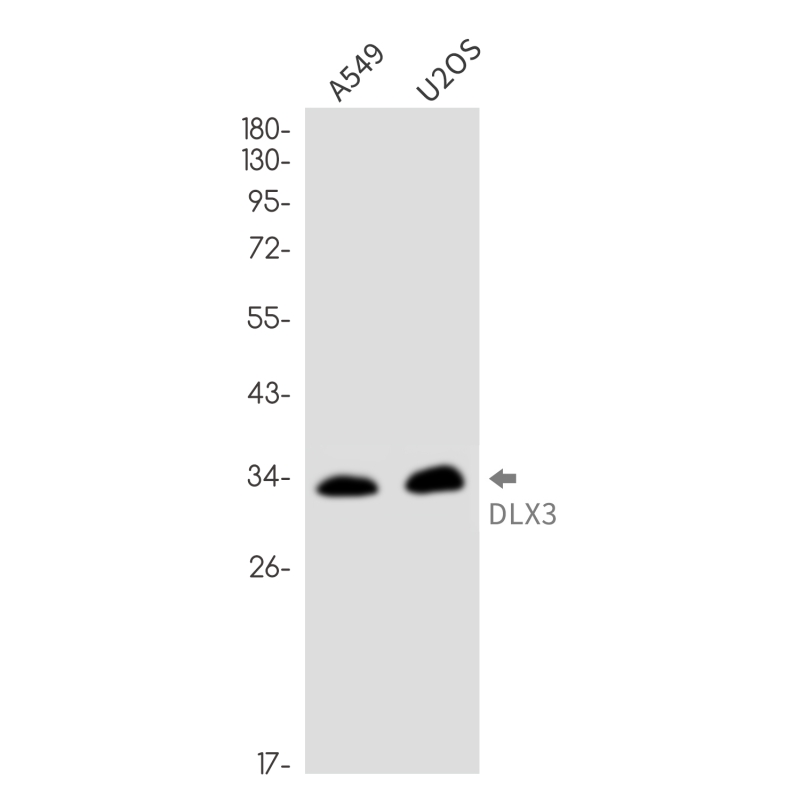
| WB | 1/500-1/1000 | Human,Mouse,Rat |
| IF | 咨询技术 | Human,Mouse,Rat |
| IHC | 咨询技术 | Human,Mouse,Rat |
| ICC | 技术咨询 | Human,Mouse,Rat |
| FCM | 咨询技术 | Human,Mouse,Rat |
| Elisa | 咨询技术 | Human,Mouse,Rat |
| Aliases | AI4; TDO |
| Entrez GeneID | 1747 |
| WB Predicted band size | Calculated MW: 32 kDa; Observed MW: 32 kDa |
| Host/Isotype | Rabbit IgG |
| Antibody Type | Primary antibody |
| Storage | Store at 4°C short term. Aliquot and store at -20°C long term. Avoid freeze/thaw cycles. |
| Species Reactivity | Human |
| Immunogen | A synthetic peptide of human DLX3 |
| Formulation | Purified antibody in TBS with 0.05% sodium azide,0.05%BSA and 50% glycerol. |
+ +
以下是关于DLX3抗体的3篇示例参考文献(注:以下为模拟示例,实际文献需通过学术数据库核实):
---
1. **文献名称**: *"A monoclonal antibody against DLX3 reveals its role in craniofacial development"*
**作者**: Zhang Y, et al.
**摘要**: 本研究开发了一种针对DLX3蛋白的单克隆抗体,并通过免疫组化和Western blot验证其特异性。研究发现DLX3在小鼠胚胎颅面发育中高表达,尤其在牙齿和骨形成区域,提示其在组织分化中的关键调控作用。
---
2. **文献名称**: *"DLX3 mutations and aberrant protein expression in tricho-dento-osseous syndrome"*
**作者**: Hassan M, et al.
**摘要**: 利用商业DLX3抗体分析遗传性综合征患者的组织样本,发现特定突变导致DLX3蛋白亚细胞定位异常。研究揭示了DLX3功能异常与牙釉质发育不全及毛发结构缺陷的关联。
---
3. **文献名称**: *"DLX3 regulates osteoblast differentiation via BMP signaling: Insights from antibody-mediated protein knockdown"*
**作者**: Lee S, et al.
**摘要**: 通过DLX3抗体介导的功能阻断实验,证明DLX3通过调控BMP通路促进成骨细胞分化。抗体在染色质免疫沉淀(ChIP)中的应用进一步证实其与靶基因启动子的直接结合。
---
如需实际文献,建议在PubMed或Google Scholar中检索关键词“DLX3 antibody”、“DLX3 immunohistochemistry”或结合具体研究领域(如“DLX3 hair development”)。
The DLX3 antibody is a research tool designed to detect and study the Distal-less homeobox 3 (DLX3) protein, a member of the DLX family of transcription factors. DLX3 plays critical roles in embryonic development, particularly in the morphogenesis of ectodermal tissues such as teeth, hair follicles, and nails, as well as skeletal and craniofacial development. It regulates gene expression by binding to specific DNA sequences, influencing cell differentiation, proliferation, and apoptosis. Mutations in the DLX3 gene are linked to human disorders like tricho-dento-osseous syndrome (TDO), characterized by defects in hair, teeth, and bone.
In research, DLX3 antibodies are widely used in techniques such as Western blotting, immunohistochemistry (IHC), and immunofluorescence (IF) to investigate DLX3's expression patterns, localization, and interactions in both normal and pathological contexts. They are essential for studying DLX3's role in developmental biology, cancer (e.g., melanoma, breast cancer), and tissue regeneration. Commercial DLX3 antibodies are typically raised against specific epitopes of the human or mouse DLX3 protein, with validation in relevant experimental models. Recent studies also explore DLX3's involvement in signaling pathways (e.g., BMP, Wnt) and its potential as a therapeutic target. Proper antibody validation remains crucial to ensure specificity and reproducibility in these applications.
×